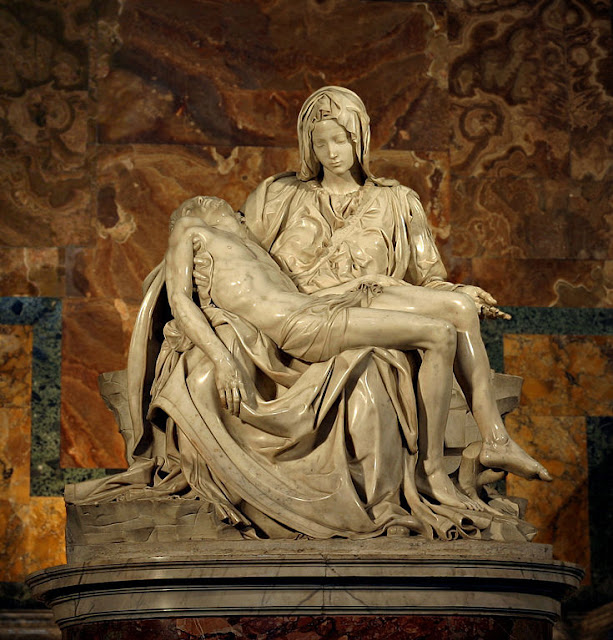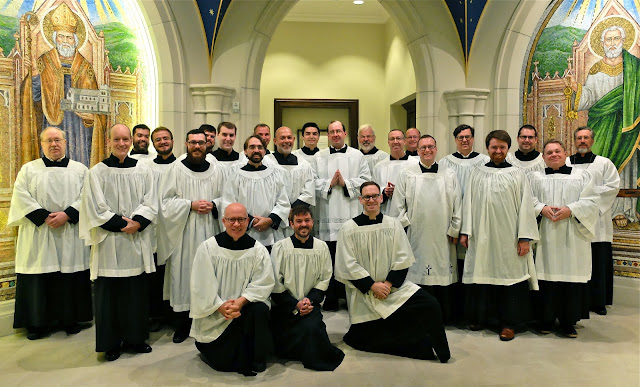Renovatio | Becoming Alive In The Sacred Liturgy
Renovatio
a renewing, renewal
renovation (n.)
c. 1400, renovacyoun, in theology, "spiritual rebirth wrought by the Holy Spirit," also in a general sense, "rebuilding, reconstruction; a making new after decay, destruction, or impairment," from Old French renovacion (13c.) and directly from Latin renovationem (nominative renovatio) "a renewing, renewal; a rest," noun of action from past-participle stem of renovare "renew, restore," from re- "again" (see re-) + novare "make new," from novus "new".
To renew is not to reduce (in value, in beauty, or in influence). Anyone with the skill to renew fine wooden furniture or restore a priceless painting understands that preservation of the original is essential to the process of restoration, which necessarily retains the full integrity of the original artist's work.
Renewal requires care and the preservation of the finest details. Without such dedication, colossal mistakes can be and have been made. A valued painting can be stripped down to the canvas, or a fine wooden piece can be reduced to a caricature of its original form. Discoloration can ensue, and details can be lost. Which is to say, meaning is lost. The same applies to the Liturgy. Reverence for tradition and meticulous attention to detail are necessary to ensure that the Faith is handed on undefiled. One must know the subject intimately. Just as a skilled restorer breathes new life into art, so too does the careful celebration of liturgy enrich the spiritual journey of the faithful, preserving the Faith of the Apostles for the mission of the salvation of souls. This commitment to authenticity not only fosters a deeper connection to the sacred but also inspires a renewed vigour among the congregation.
What do Catholics need to believe that Jesus Christ is really present in the Holy Eucharist? While some say better catechesis is needed, (Bishop Steven J. Lopes), bishop of North America’s youngest diocese, says Catholics need to experience the real presence of Jesus through worship and fellowship in the beauty of holiness.
God and Christ's gift of himself in the Eucharist is not an idea. It’s not an idea to be captured by the mind. It is a true self-gift. It is a personal gift of Christ to his Church, to the soul of the believer.
And therefore, as a personal gift, it has to be understood and received as a real person, which involves so many more aspects of the person (in addition to) the mind. So worship – “the worship of God in the beauty of holiness,” as we say in the Psalms, has to involve the whole person. It has to capture all of the senses: sight, and smell and touch and even taste. That beauty in worship takes the faith in the real presence and makes it experienced; it makes it something that can be experienced. So the Ordinariate’s accent on beauty in worship — they all say we take worship very seriously and we do because it's a very serious thing — it is the appearance of God on Earth, and receiving the gift of Christ’s self-gift is a tremendous thing.
Becoming Alive
In the Mass, if we let ourselves, we become enticed by God into the mystery of God in the love of Christ. The visible and physical rituals of the Mass, those nonverbal "words and sentences" that at once express intent and focus identity and communicate relationship, reinforce in one a right disposition to the action and person of Christ. The art of the Mass forms in us an openness to the grace of God. The heart and mind grafted to Christ by the Holy Ghost will rest in the Word of God, the Logos Who is God-Made-Flesh. If we become preoccupied with seeking a spiritual drug, we miss the opportunity to be present to the Giver, God Himself.
Spectacle - no; mystery of God - yes.By now, many, if not most, reading Catholics have discovered the Holy Father's comments about mystery versus spectacle and the hindrance that spectacle creates if imposed on the Sacred Liturgy. This distinction invites a deeper reflection on the essence of worship, urging the faithful to engage with the sacred in a manner that prioritizes reverence and authenticity over mere visual stimulation. As such, it encourages a return to the profound spirituality that can often be overshadowed by the allure of grandiose displays.
Text of 2012 CNS interview with future Pope Leo XIV on new evangelization
Q: How can the church attract people and draw them into an experience of faith?
A: Certainly, the church has recognized after the experience of the past 50 years that we should not be trying to create spectacle, if you will, theater, just to make people feel interested in something which in the end is very superficial and not profound, not meaningful in their lives.
The young man who spoke at the synod, the catechist, the 23-year-old catechist from Rome, talked about this and the need for preparation of priests which I touch upon in my own intervention. Certainly, what liturgy should be about, what faith should be about, is somehow coming in contact with that mystery, if you will, the mystery of God who is love, God who dwells within us, God who is indeed present in humanity and who's revealed himself through Jesus Christ, the way to discover God is not really through spectacle. And I think many times people have been maybe misled, people have gone looking for God in ways that in the end have been proven to be sidetracked and not really essential in terms of discovering the mystery, if you will, the truth about who God is and what experience of living a life of faith is about.
Spectacle can be cheap and/or lavish. Cheap, as in dumbed-down music and preaching and ugly decorations that still plague parish churches. Cheapness is laxity pretending to be humility. Lavish, as in immodest liturgical dancers, extended "signs of peace" that displace the peace that is offered by Jesus present on the altar, massive light and video displays and staging that focus attention on the priest, to say nothing about brutalist architecture that does little to nurture in the soul a love of beauty and goodness, the beauty and goodness of God. Without a reorientation of liturgical thought and a restoration of right liturgical practice, the faith of Catholics will continue to diminish, and parishes will teeter on the brink of collapsing into spiritual daycare centers advertising self-help tips.
A much-needed restoration of liturgical artistry is required to facilitate respect for and realize the right enactment of liturgy. Tom Colsy, at the Catholic Herald (LINK), captures a vital dimension of Catholic liturgical theology.
from Pope Leo XIV's gentle criticism of contemporary western liturgy is a vital wake-up call
To understand the full depth of the Pope’s point, two ancient theological approaches that shape Catholic spirituality and liturgy ought to be kept in mind: cataphatic and apophatic theology. These are not theological abstractions but living currents within the Church’s prayer tradition.
Cataphatic theology is the Via Affirmativa or “positive” way. It engages the sensory world. The smell of incense rising in the sanctuary and curling through the cathedral, the sound of solemn chant reverberating through the space, the visual splendour of painted frescoes and statues, the meaningful gestures of reverent genuflection and bows – all are used to point to the divine. These are each cataphatic elements – signs that speak of God’s glory, beauty and majesty. They don’t capture God fully, but they can offer a glimpse – a brief reflection of the divine light, like the momentary glistening of a golden icon under the penetrating rays of the sun.
Apophatic theology, by contrast, is the Via Negativa, or “negative” approach. It speaks of God by saying what God is not – beyond all words, silence, mystery, the unknowable. It invites us into reverence and awe, acknowledging that God transcends human understanding. In the liturgy, this is the quiet, the sacred stillness, the spaces between words and gestures where mystery breathes. This tradition, central to mystics like Ss John of the Cross and Teresa of Ávila, teaches that the highest encounter with God is beyond words, beyond comprehension and beyond visible signs. It emphasises silence, awe and reverence, recognising that the divine mystery cannot be contained by human language.
A caustic nihilism and despondency born of two world wars and deadly ideologies tarnished cultures and moved people to seek out cheap substitutes for human warmth and meaning, e.g., pornography, religious entertainment, alternative spiritualities, and drugs. By the time the 1960s arrived, a fear of silence, of solitude, had settled in.
Many in the 1960s and 1970s turned toward eastern philosophies that claimed to offer relief from the incessant bother of commercialism that had become its own religion. The Catholic Church was not spared the intrusion of vapid music and brutalist architecture which together infected parishes with the bland and banal. Nowadays, technology makes it possible to saturate our heads with constant audio as we jog, and/or images as we sip our lattes in some neighbourhood temple to caffeine.
If not in the temple... ?
Various groups that have produced recordings of Latin plainchant have reminded us that beauty can not be suppressed. One could argue that such recordings are avenues through which the Holy Spirit has spoken to a pop-weary generation pleading for authentic sustenance, starving for substance.
The charismatic Christian shuns spectacle, the distractions that ensnare hearts and minds and trap them/us in a need for constant entertainment. The true charismatic is docile to the Holy Spirit calling each soul into communion. Catholic spirituality is not meant to be a preoccupation with self or even good gifts. Rather, the heart of Catholic spirituality is entering into communion with Jesus in the Holy Eucharist, the Giver Who is Gift.
Renovatio
The last 60 years have taught us what not to do. The Latin Church has had to endure cheap attempts to improve or "update" the liturgy when what was needed was or is still needed is formation in mystery so that those charged with the ministration of the Liturgy have their intellectual, moral, and spiritual compasses pointing in the right direction, to God. We have Pope Leo XIV (and many other subtle voices) to thank for a reminder, a reminder that is essential for the salvation of souls. Another word for reminder is renewal, or perhaps renaissance, a rebirth in understanding that is also vital for the new evangelization.
Further Reading: Address Of The Holy Father Leo XIV To Participants In The Jubilee Of Oriental Churches

.jpg)





Comments
Post a Comment
Your comments will be appreciated and posted if 1) they are on topic and 2) preserve decorum.
Stand by your word.